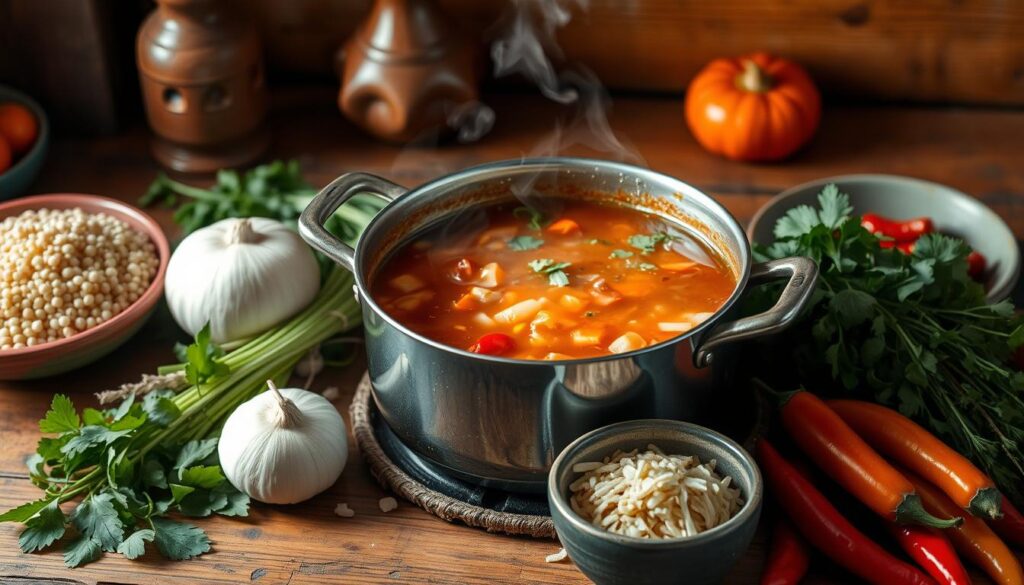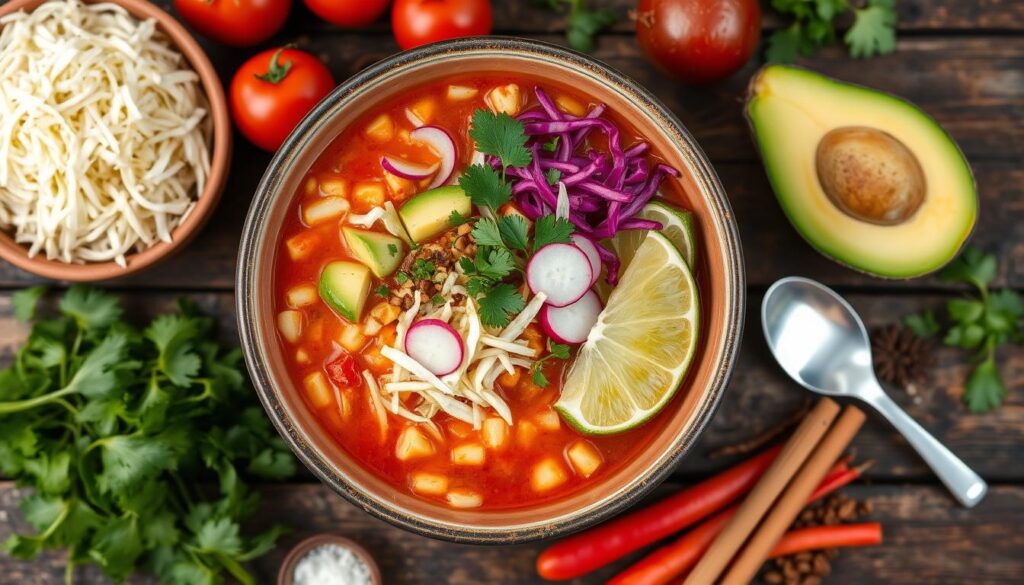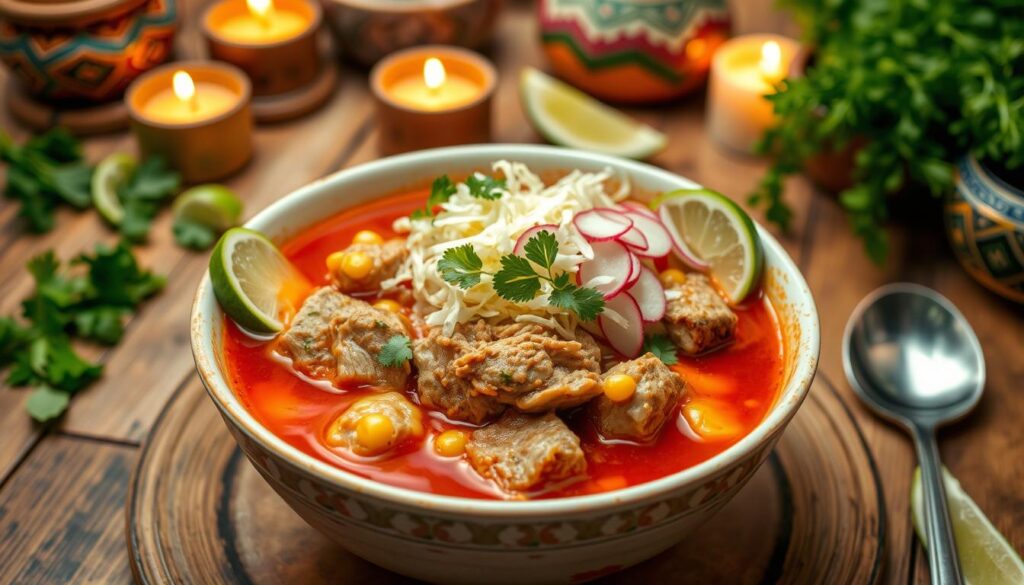Discover the heartwarming flavors of an authentic pozole recipe. It brings the soul of Mexican cuisine to your kitchen. This slow cooker pozole turns simple ingredients into a rich, comforting Mexican stew. It will transport your taste buds south of the border.
With minimal prep and maximum flavor, you’ll create a traditional dish. It serves up warmth and tradition in every spoonful.
The magic of this slow cooker pozole lies in its simplicity and depth of flavor. Tender pork, aromatic spices, and hearty hominy combine. They create a meal that’s both nourishing and deeply satisfying.
Whether you’re a seasoned cook or a curious food lover, this Mexican stew promises to become a cherished recipe. It will be a favorite in your culinary repertoire.
Key Takeaways
- Authentic pozole can be easily prepared in a slow cooker
- Perfect for feeding a crowd with minimal hands-on cooking time
- Gluten-free and dairy-free meal option
- Rich in protein and traditional Mexican flavors
- Customizable with various garnishes and toppings
Understanding Pozole: A Mexican Heritage Dish
Pozole is a beloved dish in Mexican cuisine, filled with cultural significance. It’s more than a meal; it’s a way to bring families and communities together. It celebrates Mexican traditions.
The history of pozole goes back to pre-Hispanic Mexico. It was important in ancient Aztec and Mexica cultures. They made it for special ceremonies, using ingredients that meant a lot spiritually.
Exploring Pozole Varieties
In Mexican cuisine, there are three main types of pozole. Each has its own color and way of being made:
- Pozole Rojo (Red Pozole): Known for its spicy red chile base
- Pozole Blanco (White Pozole): A lighter version without extra chile colorings
- Pozole Verde (Green Pozole): Made with green chiles and herbs for a lively taste
Cultural Significance
Pozole is more than a dish; it’s a cultural event. It’s often served at Christmas Eve and on Thursdays and Saturdays in Mexico. Making and sharing pozole shows the warmth and hospitality of Mexican traditions.
“Pozole is more than food; it’s a connection to our heritage and a celebration of family.” – Mexican Culinary Expert
When you make pozole, you join a long tradition. It’s a way to bring people together through tasty, meaningful food.
Essential Ingredients for Authentic Slow Cooker Pozole
To make real pozole, you need to pick the right ingredients. These ingredients add depth and traditional flavor to this Mexican stew. Start your journey to making the best slow cooker pozole by knowing the key parts.
The heart of a great pozole is its main ingredients. You’ll need proteins, dried chiles, and Mexican aromatics. These turn a simple stew into a masterpiece.
Core Pozole Ingredients
- Pork shoulder (2.5 pounds)
- White or yellow hominy (2 cans)
- Dried chiles (ancho, guajillo, chile de arbol)
- Chicken broth
- Fresh onion and garlic
- Dried oregano
- Fresh lime juice
Dried Chiles: The Flavor Powerhouse
Choosing the right dried chiles is key for real pozole. Each chile adds a special flavor. Ancho chiles are mild and sweet, while guajillo chiles are tangy and sharp.
“The soul of pozole lives in its chiles – they’re not just ingredients, they’re storytellers of Mexican culinary tradition.”
Hominy: The Distinctive Ingredient
Hominy makes pozole unique. These corn kernels are processed to be chewy. This makes pozole different from other stews.
| Ingredient | Quantity | Nutritional Impact |
|---|---|---|
| Hominy | 2 (15.5 oz) cans | 2g Carbohydrates per serving |
| Pork | 2.5 pounds | 26g Protein per serving |
| Dried Chiles | 3-4 varieties | Rich in vitamins A and C |
By choosing and preparing these key ingredients, you’ll make a slow cooker pozole. It will honor Mexican cooking traditions and please your taste buds.
Selecting the Perfect Cut of Pork
Choosing the right meat is key to making delicious pozole. The best cut should handle long cooking times well. It should also stay tender and flavorful.
Why Pork Shoulder Reigns Supreme
Pork shoulder, also known as Boston butt, is the top pick for pozole. This cut is from the pig’s shoulder. It has many benefits:
- Rich marbling for juicy meat
- Becomes tender with slow cooking
- Deep flavor that goes well with spices
Alternative Meat Options
While pork shoulder is the best, you can choose other meats too:
| Meat Cut | Suitability for Pozole | Cooking Recommendation |
|---|---|---|
| Country Style Pork Ribs | Good Alternative | Trim excess fat, cut into cubes |
| Fresh Ham | Traditional Option | Requires longer cooking time |
| Picnic Ham | Flavor-Rich Choice | Remove skin before cooking |
Proper Meat Preparation Techniques
Preparing pork is an art that makes your pozole amazing. Here are some expert tips:
- Trim visible fat to prevent greasy texture
- Cut meat into 2-inch cubes for even cooking
- Brown meat before slow cooking to enhance flavor
- Season generously with salt and chili powder
Pro tip: A 3-pound pork shoulder is perfect for serving 8 people in your pozole recipe.
Pro Chef’s Secret: The secret to amazing pozole is patience. Let your meat slow-cook until it’s tender, which takes 6-8 hours in your slow cooker.
The Role of Hominy in Traditional Pozole
Hominy is the heart of authentic pozole, making it a true Mexican culinary masterpiece. It’s not just for decoration. It’s what makes pozole special, giving it a unique texture and flavor.
White hominy comes from a special corn-making process called nixtamalization. This method soaks dried corn in lime water. It makes the corn soft and nutritious, creating the perfect texture for pozole.
“Hominy is more than an ingredient – it’s a cultural connection to centuries of Mexican culinary tradition.”
Key Characteristics of Hominy in Pozole
- Provides substantial texture to the stew
- Offers a distinctive corn flavor
- Adds nutritional value to the dish
- Creates the signature pozole consistency
When making pozole, use canned white hominy for ease. Most recipes need two 15-ounce cans, drained but not rinsed. The hominy soaks up the broth’s flavors, making each spoonful plump and tasty.
Selecting the Right Hominy
- Choose white or yellow canned hominy
- Look for high-quality, well-drained kernels
- Ensure the hominy appears uniform in size
- Check for freshness and no signs of damage
Understanding hominy’s role shows why it’s key to making real, flavorful pozole. It connects you to Mexican culinary heritage.
Slow Cooker Pozole: Step-by-Step Preparation
Making a real slow cooker pozole recipe needs careful steps and attention. This traditional Mexican stew mixes rich flavors and tender meat. It turns simple ingredients into a cozy meal.
Preparing the Chile Base
Your chile paste is the heart of the pozole. For the best taste, follow these steps:
- Choose 6-8 dried guajillo chiles for authentic flavor
- Remove seeds and stems from the chiles
- Soak chiles in hot water for 15-20 minutes
- Blend chiles with roasted garlic and onion
- Strain the mixture to create a smooth chile paste
Meat Browning Technique
Browning pork is key for deep, rich flavors in your pozole. Use a heavy skillet for perfect caramelization:
- Cut 3 pounds of pork shoulder into large chunks
- Season generously with salt and pepper
- Heat oil in a cast-iron skillet
- Brown meat on all sides until golden and crusty
- Transfer browned meat to the slow cooker
Slow Cooking Instructions
The magic of pozole unfolds during slow cooking. Here’s a detailed guide to a perfect stew:
| Ingredient | Quantity | Preparation |
|---|---|---|
| Pork | 3 pounds | Browned and seasoned |
| Hominy | 60 ounces | Rinsed and drained |
| Chile Paste | 1 cup | Strained and mixed |
| Broth | 8 cups | Added to slow cooker |
“Slow cooking transforms simple ingredients into a deeply satisfying Mexican comfort food.” – Traditional Mexican Chef
Cook your slow cooker pozole on low for 8 hours or high for 4 hours. Pro tip: Add fresh lime juice just before serving. It brightens the flavors and brings out the traditional taste of this beloved Mexican stew.
Creating the Perfect Pozole Broth
Making a true pozole broth needs focus on Mexican flavors. Start with top-notch ingredients for a deep, rich taste. This comes from slow cooking.

For a great pozole broth, mix the right parts. Use 8 cups of low-sodium chicken broth as the base. The chile paste adds depth and color.
Key Ingredients for Pozole Broth
- 2 14-ounce cans of fat-free, lower-sodium chicken broth
- Dried ancho chiles
- Dried guajillo chiles
- Chiles de arbol
- 1 1/2 teaspoons ground cumin
Make the chile paste for rich flavors. Soak the dried chiles for 30 minutes. Then, blend them with garlic and onion for a vibrant paste.
“The soul of pozole is in its broth – a delicate balance of heat, depth, and complexity.” – Traditional Mexican Cooking Wisdom
Broth Preparation Techniques
| Cooking Method | Cooking Time | Flavor Intensity |
|---|---|---|
| Slow Cooker | 6 hours on low | Rich and Deep |
| Stovetop | 3-4 hours | Moderate |
| Instant Pot | 45-60 minutes | Quick and Robust |
Slow cooking lets the pork flavor the broth. This makes a sublime pozole broth. Season with salt and pepper for the perfect taste.
Essential Spices and Seasonings
Making the perfect pozole is all about the right mix of mexican spices. These spices add depth and character to this traditional Mexican stew. The right blend turns a simple dish into a masterpiece that shows off authentic Mexican flavors.
Traditional Mexican Herbs and Spices
The flavor of your pozole depends on the herbs and spices you choose. Key ingredients for this classic dish are:
- Dried Mexican oregano – a crucial authentic flavoring
- Chili powder for foundational heat
- Ground cumin for earthy undertones
- Bay leaves for aromatic complexity
Balancing Heat Levels with Precision
Seasoning pozole is all about managing heat. Chipotle peppers in adobo sauce are a smart way to add spice. Start with one pepper and add more as you like it.
| Spice | Quantity | Flavor Profile |
|---|---|---|
| Dried Oregano | 2 tablespoons | Authentic Mexican herb, slightly peppery |
| Chili Powder | 1.5 tablespoons | Provides foundational heat |
| Ground Cumin | 1 teaspoon | Adds earthy, warm undertones |
“The secret to great pozole is in the balance of spices – not too hot, not too mild, but just right.” – Traditional Mexican Chef
Remember, salt and pepper are your last tools for seasoning. Taste as you go and adjust the spices. This way, you’ll create a flavor that honors Mexico’s rich culinary traditions.
Traditional Garnishes and Toppings
Make your pozole special with vibrant Mexican garnishes. These toppings add flavor, texture, and beauty to your dish.
Authentic mexican garnishes make pozole unforgettable. Here are the must-have toppings:
- Fresh Herbs: Chopped cilantro adds a bright, citrusy taste
- Sliced radishes for a crisp, peppery crunch
- Diced white onions for a sharp, clean flavor
- Creamy avocado chunks
- Crumbled Cotija cheese
- Lime wedges for a tangy squeeze
For those who love heat, try these optional garnishes:
- Hot sauce
- Red pepper flakes
- Dried chile powder
“The magic of pozole lies not just in its rich broth, but in the colorful array of toppings that let each diner customize their bowl.” – Mexican Culinary Tradition
Pro tip: Serve your pozole with warm corn tortillas or crispy tortilla chips. These toppings are more than garnishes. They’re an interactive way to connect with Mexican heritage.
Nutritional Information and Benefits
Discover the nutritional powerhouse of pozole, a healthy Mexican food. It offers more than just delicious flavor. This traditional stew packs a significant nutritional punch that can support your overall wellness and provide essential nutrients.

Caloric Content and Macronutrients
A single cup of pozole delivers a balanced nutritional profile. It makes it an excellent meal choice. Here’s a breakdown of its key nutritional components:
- Calories: 214 per serving
- Protein: 18 grams (32-38% of daily recommended intake)
- Carbohydrates: 12 grams
- Fat: 10 grams
Health Benefits of Ingredients
Pozole nutrition goes beyond basic macronutrients. The dish is rich in essential minerals and vitamins. These contribute to your overall health:
| Nutrient | Percentage of Daily Value |
|---|---|
| Niacin | 36% |
| Sodium | 25% |
| Zinc | 20% |
| Phosphorus | 15% |
| Potassium | 8% |
| Iron | 7% |
“Pozole is not just a meal, it’s a nutritional journey through Mexican culinary tradition.”
The hominy used in pozole provides additional health benefits. Through the nixtamalization process, corn develops resistant starch. This can help improve blood sugar control and enhance insulin sensitivity. For those with dietary restrictions, pozole is naturally gluten-free, making it an inclusive meal option.
When preparing pozole, choose lean meat cuts and watch portion sizes. This helps manage sodium, fat, and calorie intake. Pairing your pozole with a fresh side salad can further boost its nutritional value. This adds extra fiber and essential nutrients.
Storage Tips and Leftover Ideas
Storing pozole correctly lets you enjoy this tasty Mexican stew for days. You can keep your homemade pozole fresh in an airtight container in the fridge for up to 4-5 days. This makes meal planning easy.
There are many tasty ways to use leftover pozole. You can turn your traditional stew into exciting new dishes:
- Pozole Tacos: Shred the meat and use as a flavorful taco filling
- Pozole Rice Bowls: Serve over steamed rice for a hearty lunch
- Pozole Quesadillas: Use the meat and hominy as a rich quesadilla stuffing
Freezing leftover pozole is a great way to keep your meal fresh. You can store the stew in the freezer for up to 2-3 months. Pro tip: Separate the liquid broth from solid ingredients before freezing to maintain the best texture.
“Pozole tastes even better the next day as the flavors continue to develop and meld together!” – Traditional Mexican Cooking Wisdom
Reheating leftover pozole needs some care. When warming your stored pozole, add a splash of chicken broth or water to restore the original consistency. You can reheat on the stovetop or in the microwave, stirring occasionally to ensure even heating.
- Stovetop Method: Warm on medium-low heat, stirring frequently
- Microwave Method: Heat in 30-second intervals, stirring between each
By following these storage tips and exploring creative leftover pozole recipes, you’ll maximize the enjoyment of your traditional Mexican comfort stew.
Serving Suggestions and Side Dishes
When you’re ready to serve your slow-cooked pozole, think about making your meal special. Add some vibrant sides and drinks to make it unforgettable. This way, your meal will be more than just tasty; it will be an experience.
Traditional Accompaniments
Your pozole needs fresh garnishes for everyone to make it their own. Offer a colorful mix of toppings:
- Diced avocado
- Finely chopped red onion
- Fresh cilantro leaves
- Crisp shredded cabbage
- Lime wedges
- Crushed tortilla chips
Beverage Pairings
Choosing the right drinks can make your pozole meal even better. Here are some great options:
- Horchata – A cool, creamy rice drink
- Mexican craft beer
- Agua fresca
- Cilantro margarita for adventurous palates
“The right drink can transform a good meal into an unforgettable culinary journey.”
Light, crisp drinks are best with pozole’s rich flavors. Your guests will love the effort you put into the sides and drinks.
Conclusion
Creating homemade pozole is more than cooking a meal. It’s diving into a rich Mexican tradition. This dish connects you to centuries of cooking, turning simple ingredients into something special.
The slow cooker makes making pozole easy for everyone. You’ve learned how to mix dried chiles, tender pork, and soft hominy. This creates a stew full of flavor and history.
Mastering pozole is a great way to explore Mexican cuisine. Your homemade pozole will impress at any family dinner or special event. Cooking is about passion, practice, and sharing great meals with loved ones.
With time, you’ll add your own twist to this classic dish. Your pozole will show off both traditional methods and your own style. Enjoy the journey, relish the flavors, and celebrate Mexico’s rich culinary heritage.
FAQ
What is pozole and where does it come from?
What cut of pork is best for pozole?
What is hominy, and why is it important in pozole?
How long does it take to cook pozole in a slow cooker?
What are traditional pozole garnishes?
How can I store leftover pozole?
Is pozole nutritious?
What are some beverage pairings for pozole?
My team and I love hearing from you! submit your question or recipe review here :
There are no reviews yet. Be the first one to write one.

